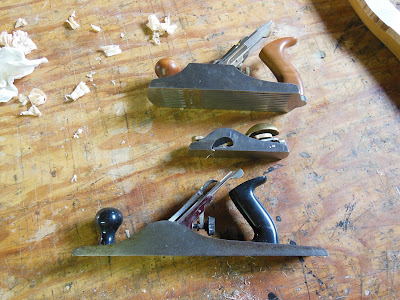I no longer joint sound-board panels with the machine, ultimately the hand plane does a better job. Unlike the hand plane, the machine Jointer produces a series of little scoops, the frequency of which depends on the feed rate of the work. A dull machine also tends to crush the wood cells, rather than cutting through them, which can cause a poor glue joint. At least one manufacturer of pianos is still jointing sound-board panels this way.
In the first picture you can see the very simple jig, or shooting board, that I use for jointing thin boards. On some, more traditional shooting boards, there might be a wooden hook at one end to hold the work. My jig uses small C-clamps (see below).
With the work clamped in place the board can be planed with the long, 24 inch, jointer plane. This keeps the edge square, and saves the worker the trouble of balancing the plane on the thin edge of the board, were it clamped vertically.How force is applied to the hand plane, determines whether the resulting cut is convex concave, or straight. Traditionally, workers tended to plane the edges of boards, to be glued, slightly concave. This would compensate for the fact that boards dry primarily through the end grain, which in dry conditions causes the ends of the boards to be temporarily smaller than the middle. It is best not to overdo this by more than a scant millimeter, if at all.
A small square is used in adjusting the squareness of the plane iron.








Comments
Post a Comment